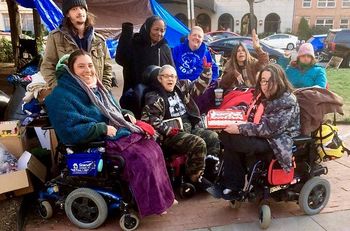There has been a long history of abuse and forced institutionalization of disabled people under the veil of "treatment". In 1999, the Olmstead vs. L.C. and E.W. decision mandated that under the ADA, those with mental illnesses could not be institutionalized against their will, and should be allowed to live in their home community. ADAPT supported this decision, but little was done to enforce it. Many cite the Olmstead decision as evidence against "treatment" devices like GEDs, which are described by many as painful and are scientifically proven to be ineffective once the patient leaves the institution, according to Dr. Gregory Fritz of the American Academy of Child and Adolescent Psychiatry.
The Judge Rotenburg Center is framed as an educational institution for severely disabled people, but disability rights groups say that the "school" is anything but. The "aversive therapy" the school touts as highly successful includes spraying students with water, making them smell noxious chemicals, pinching, and GEDs. This is viewed by many as abuse, and multiple deaths have occurred at the JRC and institutions like it. The JRC is the only institution of its kind left in the US, and still uses GEDs, food deprivation, and mechanical restraints on its patients. Many of the JRC's students are members of other marginalized groups, such as people of color. A psychiatrist described the scene they witnessed when they toured the school: “Street kids, kids of color, carrying these shock backpacks. It is prison-like and they are prisoners of the apparatus.”
The FDA and Trump administration have both remained silent regarding GEDs and the Judge Rotenburg Center.
Neither the President nor Gottlieb made a statement regarding the protests. However, during the protest, ADAPT members met with New Jersey Congressman Chris Smith, who agreed to write legislation prohibiting the use of GEDs. This process is ongoing.

